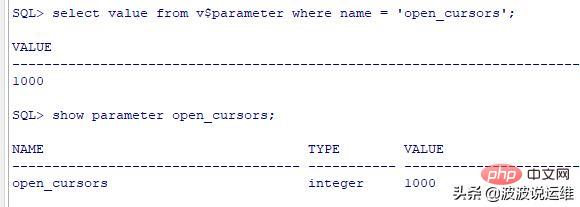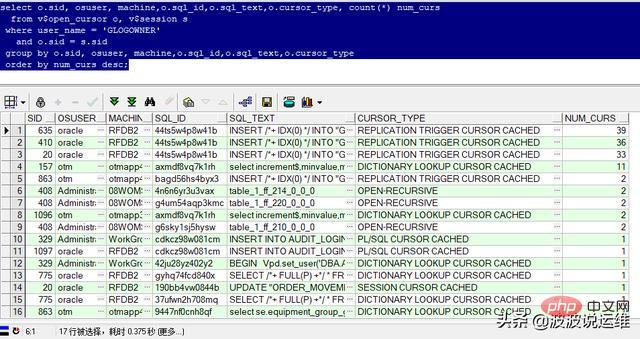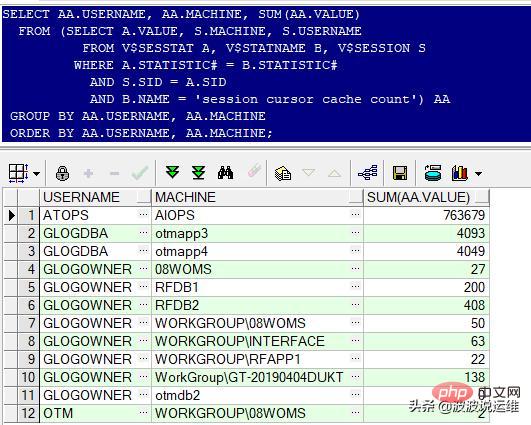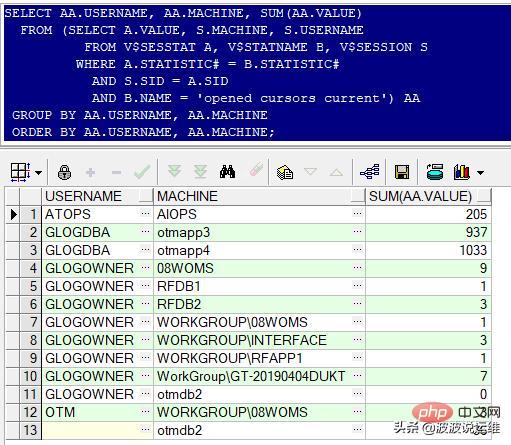How to query cursor in Oracle
Query method: 1. Use "select count(*) from v$open_cursor"; 2. Use "SELECT A.USER_NAME,COUNT(*) FROM V$OPEN_CURSOR A GROUP BY A.USER_NAME".

The operating environment of this tutorial: Windows 7 system, Oracle 11g version, Dell G3 computer.
1. Check the number of system cursors (maximum number of cursors)
select value from v$parameter where name = 'open_cursors';show parameter open_cursors;

2. Check the number of currently open cursors
select count(*) from v$open_cursor;

##3. Check the cursor usage
select o.sid, osuser, machine,o.sql_id,o.sql_text,o.cursor_type, count(*) num_curs from v$open_cursor o, v$session s where user_name = 'GLOGOWNER' and o.sid = s.sid group by o.sid, osuser, machine,o.sql_id,o.sql_text,o.cursor_type order by num_curs desc;

4. Modify the maximum number of cursors in Oracle
according to Cursor occupancy: Analyze whether the program that accesses the database is releasing resources normally. If there is no problem with the program releasing resources, increase the number of cursors.alter system set open_cursors=2000 scope=both;

5. Total number of open cursors for each user
SELECT A.USER_NAME, COUNT(*) FROM V$OPEN_CURSOR A GROUP BY A.USER_NAME;

6. Find the number of cached cursors for each terminal of each user in the database
SELECT AA.USERNAME, AA.MACHINE, SUM(AA.VALUE) FROM (SELECT A.VALUE, S.MACHINE, S.USERNAME FROM V$SESSTAT A, V$STATNAME B, V$SESSION S WHERE A.STATISTIC# = B.STATISTIC# AND S.SID = A.SID AND B.NAME = 'session cursor cache count') AA GROUP BY AA.USERNAME, AA.MACHINE ORDER BY AA.USERNAME, AA.MACHINE;

7. Find the number of open cursors for each terminal of each user in the database
SELECT AA.USERNAME, AA.MACHINE, SUM(AA.VALUE) FROM (SELECT A.VALUE, S.MACHINE, S.USERNAME FROM V$SESSTAT A, V$STATNAME B, V$SESSION S WHERE A.STATISTIC# = B.STATISTIC# AND S.SID = A.SID AND B.NAME = 'opened cursors current') AA GROUP BY AA.USERNAME, AA.MACHINE ORDER BY AA.USERNAME, AA.MACHINE;

Oracle Tutorial 》
The above is the detailed content of How to query cursor in Oracle. For more information, please follow other related articles on the PHP Chinese website!

Hot AI Tools

Undresser.AI Undress
AI-powered app for creating realistic nude photos

AI Clothes Remover
Online AI tool for removing clothes from photos.

Undress AI Tool
Undress images for free

Clothoff.io
AI clothes remover

AI Hentai Generator
Generate AI Hentai for free.

Hot Article

Hot Tools

Notepad++7.3.1
Easy-to-use and free code editor

SublimeText3 Chinese version
Chinese version, very easy to use

Zend Studio 13.0.1
Powerful PHP integrated development environment

Dreamweaver CS6
Visual web development tools

SublimeText3 Mac version
God-level code editing software (SublimeText3)

Hot Topics
 1384
1384
 52
52
 How to check tablespace size of oracle
Apr 11, 2025 pm 08:15 PM
How to check tablespace size of oracle
Apr 11, 2025 pm 08:15 PM
To query the Oracle tablespace size, follow the following steps: Determine the tablespace name by running the query: SELECT tablespace_name FROM dba_tablespaces; Query the tablespace size by running the query: SELECT sum(bytes) AS total_size, sum(bytes_free) AS available_space, sum(bytes) - sum(bytes_free) AS used_space FROM dba_data_files WHERE tablespace_
 How to get time in oracle
Apr 11, 2025 pm 08:09 PM
How to get time in oracle
Apr 11, 2025 pm 08:09 PM
There are the following methods to get time in Oracle: CURRENT_TIMESTAMP: Returns the current system time, accurate to seconds. SYSTIMESTAMP: More accurate than CURRENT_TIMESTAMP, to nanoseconds. SYSDATE: Returns the current system date, excluding the time part. TO_CHAR(SYSDATE, 'YYY-MM-DD HH24:MI:SS'): Converts the current system date and time to a specific format. EXTRACT: Extracts a specific part from a time value, such as a year, month, or hour.
 How to encrypt oracle view
Apr 11, 2025 pm 08:30 PM
How to encrypt oracle view
Apr 11, 2025 pm 08:30 PM
Oracle View Encryption allows you to encrypt data in the view, thereby enhancing the security of sensitive information. The steps include: 1) creating the master encryption key (MEk); 2) creating an encrypted view, specifying the view and MEk to be encrypted; 3) authorizing users to access the encrypted view. How encrypted views work: When a user querys for an encrypted view, Oracle uses MEk to decrypt data, ensuring that only authorized users can access readable data.
 How to view instance name of oracle
Apr 11, 2025 pm 08:18 PM
How to view instance name of oracle
Apr 11, 2025 pm 08:18 PM
There are three ways to view instance names in Oracle: use the "sqlplus" and "select instance_name from v$instance;" commands on the command line. Use the "show instance_name;" command in SQL*Plus. Check environment variables (ORACLE_SID on Linux) through the operating system's Task Manager, Oracle Enterprise Manager, or through the operating system.
 How to uninstall Oracle installation failed
Apr 11, 2025 pm 08:24 PM
How to uninstall Oracle installation failed
Apr 11, 2025 pm 08:24 PM
Uninstall method for Oracle installation failure: Close Oracle service, delete Oracle program files and registry keys, uninstall Oracle environment variables, and restart the computer. If the uninstall fails, you can uninstall manually using the Oracle Universal Uninstall Tool.
 How to check invalid numbers of oracle
Apr 11, 2025 pm 08:27 PM
How to check invalid numbers of oracle
Apr 11, 2025 pm 08:27 PM
Oracle Invalid numeric errors may be caused by data type mismatch, numeric overflow, data conversion errors, or data corruption. Troubleshooting steps include checking data types, detecting digital overflows, checking data conversions, checking data corruption, and exploring other possible solutions such as configuring the NLS_NUMERIC_CHARACTERS parameter and enabling data verification logging.
 How to create oracle dynamic sql
Apr 12, 2025 am 06:06 AM
How to create oracle dynamic sql
Apr 12, 2025 am 06:06 AM
SQL statements can be created and executed based on runtime input by using Oracle's dynamic SQL. The steps include: preparing an empty string variable to store dynamically generated SQL statements. Use the EXECUTE IMMEDIATE or PREPARE statement to compile and execute dynamic SQL statements. Use bind variable to pass user input or other dynamic values to dynamic SQL. Use EXECUTE IMMEDIATE or EXECUTE to execute dynamic SQL statements.
 How to solve the problem of closing oracle cursor
Apr 11, 2025 pm 10:18 PM
How to solve the problem of closing oracle cursor
Apr 11, 2025 pm 10:18 PM
The method to solve the Oracle cursor closure problem includes: explicitly closing the cursor using the CLOSE statement. Declare the cursor in the FOR UPDATE clause so that it automatically closes after the scope is ended. Declare the cursor in the USING clause so that it automatically closes when the associated PL/SQL variable is closed. Use exception handling to ensure that the cursor is closed in any exception situation. Use the connection pool to automatically close the cursor. Disable automatic submission and delay cursor closing.




